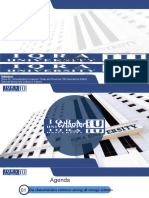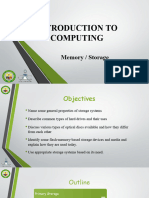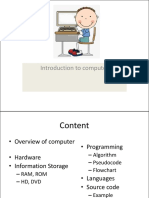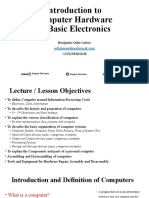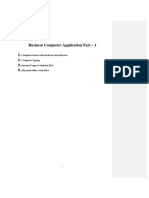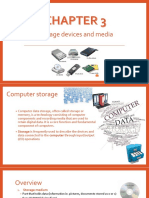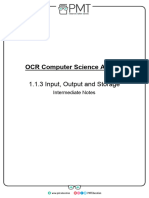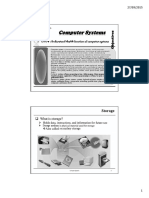0 ratings 0% found this document useful (0 votes) 26 views 11 pages 2 System Software
The document provides an overview of system software, including operating systems and applications software, detailing their functions and types. It also covers memory and storage devices, explaining the differences between RAM and ROM, as well as various storage mediums like hard disks, optical discs, and flash memory. Additionally, it discusses networking types, benefits, and security measures to protect against unauthorized access.
Copyright
© © All Rights Reserved
We take content rights seriously. If you suspect this is your content,
claim it here .
Available Formats
Download as PDF or read online on Scribd
Go to previous items Go to next items
Save 2 System Software For Later hups://t.meligese_files
System software
Operating system: The operating system controls the computer. The operating system is.
software that runs between the hardware and application software, It enables application
software to use the computer's hardware and other resources. The OS has many functions,
including the following:
Input and output control
Error handling
Resource allocation
Providing a user interface
Allowing users to give commands to the
computer
File handling
Applications software
Office productivity tools:
Office productivity software helps you work more efficiently when doing tasks in the
office. This include:
Word processing
Desktop publishing
Spreadsheet
Database
Web authoring:
Web authoring software is used to create a website. A websiteis structed collection of
web pages that is accessible via the Internet. Web pages usually include text and
graphics and are written using HTML or software that generate HTML, Web authoring
software like Adobe Dreamweaver gives you a more control over the webpage and may
include facilities to manage your website.�hups://t.meligese_files
Image and sound editing
Image and sound editing software helps you prepare and edit pictures, photographs,
video and music.
Multimedia presentation software helps you prepare for and deliver a talk to an
audience. The monitor display is projected onto a very large screen during the talk. A
presentation will consist of a series of slides with mainly text and graphics, and notes for
the speaker.
Project management software:
Project management software can be used to track and chartthe timelines of the
individual tasks or events that have to be completed in order to complete a project. A
project could be, for example, the construction of a large building.�hups://t.meligese_files
Backing Storage
Data storage capacity terminology
One kilobyte or KB is 1024 bytes
‘One megabyte (MB) is 1024 KB or 1024 x 1024 = 1 048 576 bytes
One gigabyte (GB) is 1024 MB
One terabyte (TB) is 1024 GB
Main Memory
Memory
Memory is a device used to store programs temporarily or permanently.
Main Memory
Any data or instructions that are to be processed by the CPU must be placed into main
memory (sometimes known as primary storage).
RAM
Random access memory can be written to, read from and edited. The data in it can be
accessed in any order. Ram is volatile memory, which means that it is cleared when the
computer is switched off.�htps:/Lmefigese_files
Read only memory can also be accessed in random order, but the data in it cannot be changed.
ROM is intended for permanent data, necessary for the operation of the computer system. ROM
is non-volatile, which means that it retains what is stored in it when the computer is tured off.
Types of ROM:
© Programmable read-only memory (PROM) has no data locked onto it when first
manufactured, But later, a company using PROM chips to make a computer can
Put in its own information. The data would then be locked in place, so the
memory can no longer be changed.
© Erasable programmable read-only memory gets its original data in the same way
PROM does. But, if necessary, the data can be erased using a special light
shining on a window on the chip or by electric charge,
RAM vs ROM
RAM ROM
Can be written to and read from. Can only read from.
Holds program being run and data Stores data and programs permanently.
being processed.
Volatile: it is cleared when the computer Non-volatile: it retains what is stored
is switched off. when the computer is turned off.
RAM microchips are supplied as a ROM microchips are installed in the
module plugged into the motherboard. motherboard.�hups://t.meligese_files
Storage Devices
4. Hard disks
Ahard disk drive (HDD) [note 2] is a data storage device used for storing and retrieving digital
information using rapidly rotating disks (platters) coated with magnetic material. On each
individual disk, the data is stored in concentric tracks. For every track of data, there are
corresponding tracks above and below it. The corresponding tracks form a cylinder. The number
of cylinders is equal in number to the tracks on each surface of the disk. For each surface there
is a readiwrite head, set on the tip of a small arm. These heads move in step with each other,
traversing in and out over the spinning disk. The total storage space on a hard disk is given by
the following formula:
number of readable sides x nnumber of cylinders x sector per track x bytes per sector
RAID(Redundant Array of Inexpensive Drives): this storage device essentially carries multiple
copies of data, on different hard disk drives. If one falls, the data can still be recovered from the
others.
External Hard Disks: External hard disks are built in a separate case and are robust, small and
lightweight. They can be easily and safely carried around and can usually be connected to any
computer with a USB socket.�htps:/Lmefigese_files
2. Optical discs
Compact disks (CDs): A typical CD stores around 700 MB of data on one side of the disc.
‘Access time is slower than a hard disk. A CD is a piece of plastic, about 4/100 of an inch or 1.2
mm thick. During manufacture, a pattem is etched onto the lower polycarbonate plastic layer.
This pattern is a single, continuous, extremely long spiral track of data. This lower layer is
covered with a thin, reflective aluminium layer. Then a thin acrylic layer is sprayed over the
aluminium to protect it. The CD's label is then printed onto the acrylic. CD drive has a laser
beam in the read/write head, which can read the information on the disc.
Digital Versatile discs (DVDs): A digital versatile disc looks much the same as a CD. A
single-sided layer DVD can hold up to 4.7GB on one side. In contrast, a dual-layer DVD can
carry two layers of data on each of its two sides: this means it can hold up to 18 GB of video,
audio or other information. Types of CD and DVD:
© CD-R and DVD-R allow data to be written to them on one occasion only: after this, the
data on them can only be read. This enable you to create your own music CDs and
record TV programmes on DVD, CD-R and DVD-R are useful for backing up the hard
disk on a computer, because once the data has been written it cannot be deleted or
changed.
© CD-RW and DVD-RW can be written to repeatedly up to around 1000 times and can be
used for continuously backing up data or archiving. Data recorded on them can be
deleted or replaced by more up-to-date data
© DVD-RAM may be sealed inside a cartridge and can be rewritten more than 100000
times. Data written to DVD-RAM is expected to last at least 30 years. DVD-RAM drives
are used in video recorders, camcorders and computers.
¢ HD DVDis an optical disk format for storing digital information, similar to DVD but with
sufficient capacity for high definition video and movies. Its development was supported
by a group of manufacturers led by Toshiba. HD DVD was created to succeed DVD but
found competition in Blu-ray, which is a rival format. In 2008, HD DVD marketing and
development ceased.
© Blu-ray is a high definition DVD format supported by a group of manufacturers led by
Sony, Its intended as a replaced for the current range of DVDs and is used for�hups://t.meligese_files
distributing HD material such as movies. A dual-layer Blu-ray can store 50 GB almost 10
times the capacity of a single-sided, single-layer DVD. It is the same size as a CD.
3. Flash memory
Flash memory is a type of EPROM. The memory can be reset quickly and easily so that it can
be written to, read from and edited. It retains what has been stored without a power source.
‘Acommon use of Flash memory is for the basic input/ output system (BIOS) of your computer.
On vitually every PC available, the BIOS makes sure the computer starts up as it should and
that all the parts of the computer work together.
Memory cards are removable and are used in video games consoles, digital cameras, mobile
phones, PDAs and other portable devices. PCs often have card slots, Memory cards can store
Up to 32 GB of data. There are many types of memory card, including Compact Flash (CF),
Secure Digital (SD), mini and micro SD, xD Cards, Smart media and Multimedia cards.
Flash pen devices or memory sticks plug into the USB port on a computer. They are lightweight
and fit easily into your pocket s they are a convenient way of moving data from one computer to
another. They have a storage capacity of up to 32GB. They are used by teachers and lecturers
to store presentations and other files, because they can be easily moved from one classroom to
another. They are robust and not easily damaged, and are a relatively inexpensive medium.
4, Magnetic tape
aL
Ds
omc
‘A magnetic tape is wrapped onto a reel and provides a large amount of surface area. This
abundance of surface means that a great quantity of information can be stored on a tape. But
tape storage offers only serial access. So if you want to access data at the middle of the tape
you must start at the beginning, and forward through the tape to reach the part you want. For
this reason, accessing the data on a tape can be very slow, and so magnetic tape is mostly
sed for backing up data not for quick regular access.�htps:/Lmefigese_files
Networking
Types of Network
Local area networks (LANs):
ALLAN consists of a collection of computers that can share peripherals, share
information and communicate with each other over a network. These are likely to be in
the same room, building, department, school or workplace. Each computer that forms
part of the network can function both as an independent personal computer running its
own software and as a workstation on the network accessing information from the
network server.
Local Area —-
WH cabo Coa
emp ecoeg eesc
Advantages of LAN:
Software and data files can be shared by many users.
Users can work together on a single shared document.
Users can communicate using instant messaging
Users can stream media
Users can access the network from any computer or other device that can be
attached to the network.�htps:/Lmefigese_files
Itis usually cheaper to buy one copy of a software application and pay the
license fee for several computers, than to buy individual licenses for each
computer.
Users can share hardware devices.
Users can share an Internet connection.
User's access rights can be controlled centrally.
Computers attached to the network can be maintained either centrally or from
any network station.
Disadvantages of LAN:
Set-up of server and network cabling costs high
Data can get corrupt easily.
There is a risk from viruses as they can spread easily between the computers.
Types of LAN:
On a client/server network, one or more computers are designated as the
servers, Client computers are those computers available for you to use. Clients
communicate with each other and externally through the server. The server will
have a faster processor, more RAM and a lot more backing storage space than
the client computers, A large LAN may have several servers to perform different
tasks. For instance, a file server may look after the organization of the files on the
network, while a print server coordinates printing on the network. Each server will
also have software that manages the services it provides: email and Internet
access, shared peripherals and the security of the system. Any computer that
gives a user access to any type of network, including a connection to a
mainframe computer, can be called a terminal.
A peer-to-peer network allows every computer to communicate directly with
very other computer in the network. A user can access data from any computer
on the network. They are used mainly in small business and departments.
Cabled LAN: In a cabled LAN, all the computers and other peripheral devices on the
network are attached o cables that are used to transmit data between them. A computer
must be connected to a cabled LAN using a network interface (NIC). The network cable
is plugged into the NIC.
Wireless LAN (WLAN): A wireless LAN differs from a cabled LAN in that computers
can use wireless link to connect to the network instead of being attached using a cable.
The wireless connection is made possible by three sets of components: wireless access
points; wireless network interface cards (NICs) and routers.�hups://t.meligese_files
WAN WLAN
LAN
Awireless access point contains a radio receiver, encryption and communications
software so that it can broadcast and receive wireless communications. It translates
computer signals into wireless signals, so that it can broadcast to and receive signals
from wireless network interface cards (NICs) on the network. NICs equipped for
wireless communications have a fixed or detachable radio antenna instead of usual
coaxial cable. Routers enable several computers to communicate through a wireless
access point at the same time.
Bluetooth: Bluetooth is a form of wireless communication designed to enable PDAs,
mobile phones, computers and similar devices to share information and to synchronise
data. Bluetooth requires a transceiver chip in each device. The data transfer rate is 720
kbps with a 10 metre range.
Wide area networks (WANs):
WAM can connect networks across a large geographical area, such as a city or a
country or even internationally. Information can be transmitted in many ways: for
example using high-speed telephone lines, fibre optic cables, microwave links and
satellite links, or a combination of these. WANs are used mainly by universities, large
companies and banks with branches in different countries, to share information and
processing loads.
IP address:
Each computer on the Internet has a unique address that identifies it. This unique
address is a number called IP address (Internet Protocol address), which is a 32-bit
address consisting of four sets of up to three digits each, separated by full stops. The IP
address could be static or dynamic. To connect to a computer on the Internet, your
computer needs to know its IP address.�hups://t.meligese_files
Benefits of establishing a network
By establishing a network we can:
Share peripherals from hundreds of computers.
Share data between people continuously
Communicate easily
‘Access to Internet simultaneously
Stream media
Distribute software
Network Security
Threat Protection
Hacking is unauthorised access to your Use a username and password. Don't
computer or files and to your personal__ give these to anyone and don’t write them
information, e.g. email and bank accounts. down.
Use a firewall. This is a combination of
hardware and software that controls
network traffic between a secure computer
or network and the Internet.
Use WEP (Wired Equivalent Privacy) or
WPA (Wi-Fi Protected Access) codes
which prevent unauthorised connection to
a wireless network.
Encrypt data. Encrypted data cannot be
understood by someone without the
encryption key. This prevents hackers
understanding data on the ICT systems.
they access.
Use a transaction log to track use of the
system. This can show hackers’ activities
and help identify them.




















